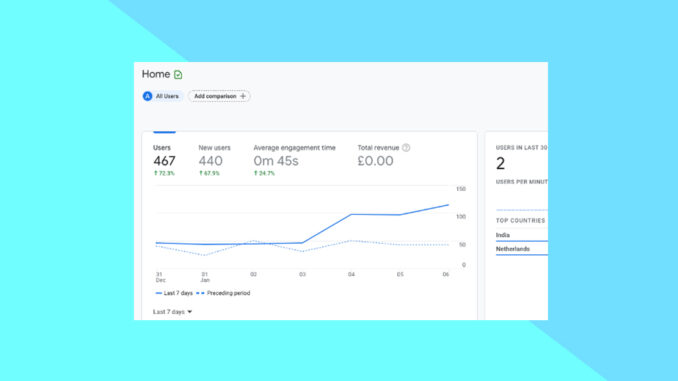
In October last year (2020), Google Analytics 4 was launched. It was branded a new, intelligent Google Analytics with machine learning at its core. Google said, “With more commerce moving online and businesses under increased pressure to make every marketing dollar count, insights from digital analytics tools are even more critical”, and we couldn’t agree more. So what do we think about it?
What is Google Analytics 4?
Google Analytics (GA) is something that all digital marketers, website owners, etc are using daily. It is a platform designed to measure the success of your website, whether you are focusing on paid ads, organic traffic, or social media. It tracks and reports on your website’s traffic, giving data insights that can inform your digital marketing strategy. Unfortunately, digital tools don’t age like a fine wine, they need to regularly be updated and/or improved to continue performing and according to Google, the old GA was not fulfilling its objectives. Most likely due to the shift in consumer behaviour and privacy driven changes, leading to its revamped and remodeled platform; GA4.
“Smarter insights to improve your marketing decisions and get better ROI”, says Google.
What does Google Analytics 4, do?
According to Google, “The new Analytics gives you customer-centric measurement, instead of measurement fragmented by device or by platform. It uses multiple identity spaces, including marketer-provided User IDs and unique Google signals from users opted into ads personalization, to give you a more complete view of how your customers interact with your business.” (Google)
Some interesting changes noted…
With an updated look and a new menu there appears to be a whole host of new and exciting areas to explore.
The menu shows updated sections such as “engagement”, “monetisation” and “retention” under the grouping of “lifecycle”. Demographics and tech have been moved to a “user” group, these were previously under audience.
You can also track App data or your Website data and events are now codeless, these can be tracked and set up within GA rather than older methods such as Tag Manager.
A quick overview of GA4’s sections…
Reports
Event Reports
How to get Google Analytics 4
It is recommended that you run the new GA4 alongside your current reporting views, to ensure you have all the data you need. If you are new to GA then GA4 will be the default property.
The setup is very simple and the best people to explain are the pros! So please see Googles guide for adding GA4 to your current property: https://support.google.com/analytics/answer/9744165?hl=en
Our Key Takeaways
SEO Team
“DebugView is an exceptional out of the box tool for breaking down individual events to a list of parameters. It helps on event set up, and doesn’t require a host of third party tooling to figure out what your set up is. You can use it in conjunction with GTM Preview and Debug mode or you can use it alone, depending on your setup.
It’s instantaneous (almost – there are some lags but it’s a brand new feature!) in comparison to the old report where you’d have to wait a significant amount of time for it to appear.
The analysis feature on GA4 is one of my personal favourites on the platform. The visualisations you are able to create within the property (without going into a custom report) is great. Its integration is smoother than the original custom reporting feature and feels more accessible. It’s really visual and allows you to break down the conversion by funnel, path as defaults or create your own custom analysis. There’s not much difference here other than how it is better integrated, you don’t have to go to a separate part of analytics, and has a better template selection for those quick, common reports.”
Beth Barnham, SEO Specialist
“GA4 is bringing increased out of the box custom events tracking capabilities. This is ideal for SME’s with little access to resources and those that might not be GTM savvy. The easier it is for people to understand how users interact with their sites, the more insight they have to report upon and make improvements.”
Crispin Boden Tebbutt, Senior SEO Specialist
Content Team
“For content, one of the key benefits will be the insights into users. The new system means we can compare new and returning users and how they behave differently onsite with ease. We can then cater to these habits with our content.
For example, insights may show new users are more likely to spend longer onsite and explore more pages as they are in an information-gathering stage, so we would create a plethora of interesting, longtail-focused content. Return users may spend less time, suggesting we need to be shorter and to the point with copy, with visible calls to action. The demographics insights will also help with defining personas. Revealing data on location, age and interests will help considerably with ideation.”
Steph Lamerton, Senior Digital Content Executive
Paid Media Team
“The setup regarding integration with e-commerce platforms is kind of tricky now, mainly for people who want to keep using the traditional GA (now, by default, GA “forces” you to use the web + app config and that won’t allow you to see conversions from you e-commerce website on GA). However, there are plenty of blogs explaining how to fix it out there.”
Lucas Iozzi, Paid Media Specialist
What are your thoughts on the “new and improved” platform? We’d love to hear them! Start a conversation with us over on our socials.

Leave a Reply